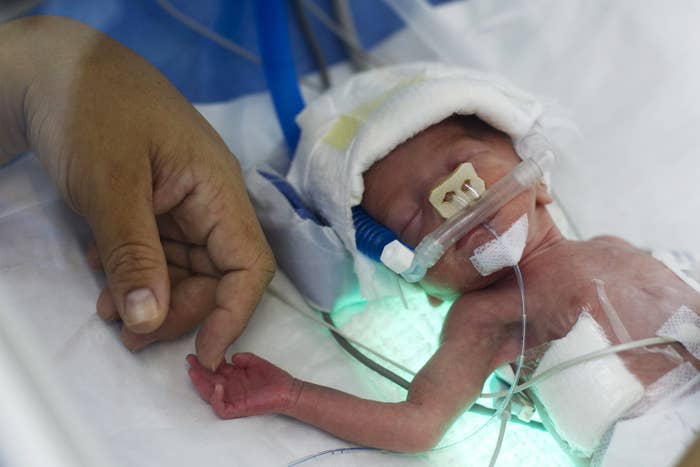
A 2010 study of 1,300 premature infants relied on faulty oxygen meters, raising alarms that the babies might be receiving too little oxygen, according to documents and emails obtained by the patient advocacy group Public Citizen.
But the scientists behind the trial say that the broken meters actually gave the babies more oxygen than expected, and did not cause additional harm.
The researchers discovered the problem three years into the study, and alerted the trial’s safety board, but did not change or stop the trial, documents show.
"This is very worrisome," neonatal pediatrics professor Neil Finer, then of the University of California San Diego School of Medicine, replied to British colleagues who informed him in June of 2008 of the oxygen meter problem.
Finer was a leader of the Surfactant Positive Airway Pressure and Pulse Oximetry Trial (SUPPORT), which aimed to answer a question that had plagued neonatal medicine for decades: whether premature infants benefit more from high or low levels of oxygen.
The $20 million, 23-hospital trial has already stoked controversy over whether its consent forms properly warned parents of risks, prompting a lawsuit (dismissed in 2013) and medical journal editorials.
But the new accusations about the oxygen meter defects, uncovered in documents obtained from a Freedom of Information Act request by Public Citizen, raise more serious questions about when it’s appropriate for researchers to halt a clinical trial.
The faulty meters potentially exposed as many as half of the 1,100 babies already enrolled in the study to dangerous periods of oxygen deficiency, or “hypoxia,” according to a June 11, 2008 analysis conducted by British researchers that was sent to Fineman.
"The ethical thing to do at that point would have been to halt the experiment," Public Citizen's Michael Carome, a former federal research misconduct official, told BuzzFeed News.
Public Citizen on Wednesday sent a letter to NIH’s Office for Human Research Protection complaining that the SUPPORT group enrolled 200 babies in the experiment even after identifying the problem.
Roughly 1 in 9 infants is born before 37 weeks of gestation. Those born very early, between 23 and 28 weeks, face harsh odds of survival, ranging from 33% to 90%. The SUPPORT trial was one of three conducted worldwide to find out whether preterm infants would face better odds of living if given more oxygen. The stakes were high because higher oxygen also increases the risk of blindness.
One of the SUPPORT trial leaders, Rosemary Higgins of the National Institute of Child Health and Human Development, told BuzzFeed News in a statement that the group had looked into the oxygen meter problem in 2008, and had determined that “those in the low oxygen group would have received more oxygen than the study design called for, not less.”
Both the high and low oxygen levels described in the published study were within the widely variable ranges used in NICUs at the time, she added. “Although the low oxygen group received more oxygen than intended, they received less oxygen than the high oxygen group, and so the decision was made to continue the trial.”
The study was published in the prestigious New England Journal of Medicine in 2010. It relied on oxygen meters that obscured to nurses and doctors in hospitals to which arm of the experiment the babies belonged to, and it also tested whether putting infants on a ventilator or an oxygen mask was a better way to supplement their oxygen levels.
The researchers found that the premature infants in the low oxygen group had a slightly higher death rate (20%) than those in the high oxygen group (16%), but the high oxygen also increased the risk of blindness.
“Clinical investigators acted in good faith to design a trial to address an important question,” NEJM editor Jeffrey Drazen wrote in 2013, defending the researchers against complaints that they should have known of the risk from the low oxygen levels before starting the trial.
The level of oxygen actually produced by the machines was “Impossible to know” in the middle of the trial, before the statistics were final, Finer summarized in a July 2008 presentation to the team. The documents also show that the SUPPORT team “really had no idea if they had solved the problem when they decided to continue the trial, which is unacceptable,” Carome said.
Those statistics eventually showed that the faulty oxygen meters led to the low-oxygen group of preemies getting 1% to 2% more oxygen than originally intended, according to Higgins.
Before the July 2008 presentation, the study team alerted the head of an outside safety board, Gordon Avery, also of the University of California, San Diego. He did not think the broken machines were reason to stop the trial, writing to Higgins “the fact that oxygen [levels] wander a lot in very sick preemies is part of that real world.”
“It seems everyone crossed their fingers and hoped for some significant results. But not necessarily the ones they got,” bioethicist Jon Merz of the University of Pennsylvania told BuzzFeed News.
“I would like to think that if I were on the [safety board], I would have voted differently.”
